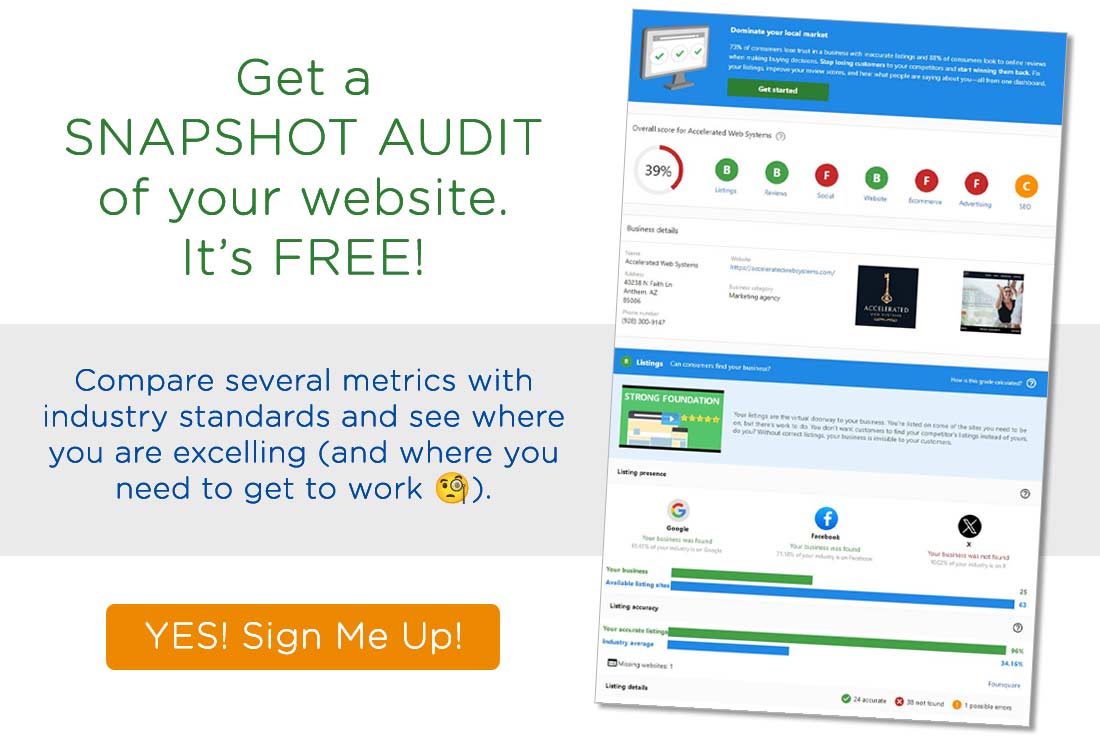Keyword Phrase Evaluation
When it comes to Search Engine Optimization (SEO), one of the first steps is selecting the right keyword phrases. These keyword phrases are the backbone of a successful SEO strategy and can determine how fast a website ranks organically and how much traffic to your site can be generated.
But how are keyword phrases evaluated? What makes one keyword better than another?
Below are the 10 steps we take during our keyword phrase research – covering metrics such as search volume, competition, intent, relevance, locality, brands, and keyword difficulty.
Understanding these factors – both the data AND human behavior – helps us choose the best keywords to optimize your website for and maximize your SEO efforts.
1. Search Volume: Measuring Demand
Search volume is the number of times a keyword or phrase is searched for in a given time frame, usually monthly. Higher volumes indicate that more people are searching using that phrase, making it potentially more valuable in driving traffic to your website. However, search volume alone isn’t the sole determining factor for whether a keyword is worth targeting.
High Search Volume
Keywords with high search volumes often have significant competition, which can make it difficult for smaller websites to rank for them.
Low Search Volume
Long-tail keywords (phrases that are more specific and often longer) usually have lower search volumes but are easier to rank for and often convert better because they target more specific user queries.
2. Competition: Assessing Rivalry
Keyword competition refers to how difficult it is to rank for a particular keyword based on how many other websites are also targeting that phrase. SEO tools typically provide a metric for competition, often displayed as low, medium, or high, or as a numeric difficulty score.
High Competition
Keywords with high competition are often more general, and ranking for them requires extensive SEO efforts, including a strong backlink profile and highly authoritative content.
Low Competition
These keywords are easier to rank for but may have lower search volumes. However, they can be more effective for niche markets or newer websites with less authority.
Tools for Evaluating Competition
Using tools like Google Keyword Planner, Ahrefs, Moz, or SEMrush can help you assess keyword competition more accurately. These tools analyze how many competitors are ranking for specific keywords and provide a difficulty score, allowing you to prioritize lower competition phrases that you have a higher chance of ranking for.
3. Keyword Intent: Understanding the User’s Goal
Search intent, or user intent, is the primary goal a user has when typing a keyword phrase into a search engine. Understanding intent is essential because it directly affects how well your content aligns with what users are looking for.
There are four main types of keyword intent:
Informational
The user is looking for information, typically in the form of a question or query (e.g., “how to fix a leaking faucet”).
Navigational
The user is trying to navigate to a specific website or page (e.g., “Facebook login”).
Transactional
The user intends to make a purchase or perform a specific action (e.g., “buy iPhone 15 online”).
Commercial Investigation
The user is researching products or services before making a decision (e.g., “best smartphones 2024”).
Evaluating the intent behind a keyword phrase helps you ensure that your content matches what users are seeking. For example, targeting a transactional keyword with an informational blog post may not yield the best results, as the content would not fulfill the user’s intent to purchase.
4. Relevance: Matching Your Content to Keywords
Keyword relevance refers to how well a keyword phrase aligns with your business, website, or the specific piece of content you’re creating. A keyword with a high search volume but little relevance to your offering won’t benefit you. Instead, it’s crucial to find keyword phrases that not only generate traffic but also attract the right kind of audience—those who are likely to convert into leads or customers.
To evaluate relevance:
Align with Your Business Goals
Choose keywords that reflect the products or services you offer.
Create Content that Answers Queries
Ensure that your content provides solutions or value that directly ties into the keyword phrase.
5. Keyword Difficulty: Balancing Effort and Reward
Keyword difficulty is a metric that assesses how hard it is to rank for a keyword. It takes into account factors like the authority of sites currently ranking for that keyword, the number of backlinks they have, and how well-optimized their content is. Tools like Ahrefs and SEMrush provide a keyword difficulty score to help evaluate how challenging it will be to rank for a specific keyword.
High-Difficulty Keywords
Often, these are short, broad keywords with high search volumes and strong competition. They require a lot of resources, time, and effort to rank for.
Low-Difficulty Keywords
These keywords may have lower search volumes but offer quicker ranking opportunities, especially for smaller businesses or new websites.
Evaluating the balance between keyword difficulty and potential traffic or conversion opportunities is key to building a realistic SEO strategy.
6. Cost-Per-Click (CPC): Understanding Keyword Value for Paid Campaigns
If you’re considering using keywords in paid advertising, such as Google Ads, evaluating the cost-per-click (CPC) can provide insight into how valuable the keyword is in the marketplace. High CPC keywords are more expensive to bid on in paid search campaigns, which typically means they are highly competitive and valuable, often due to their commercial intent.
While CPC doesn’t directly affect organic rankings, it can help you assess how lucrative a keyword phrase might be if you’re looking to add it to your website.
7. Trends: Watching Keyword Popularity Over Time
Keyword popularity can fluctuate over time, making it important to evaluate whether a keyword is trending upward, staying stable, or declining in interest. Google Trends is a valuable tool for assessing whether the search volume for a particular keyword is growing or decreasing, helping you make more informed decisions about which phrases to prioritize.
For example:
Seasonal Trends
Keywords like “Christmas gifts” spike during the holiday season.
Emerging Keywords
New products or trends can cause keyword phrases to rise rapidly in search volume, making them valuable targets for timely content creation.
8. Long-Tail Keywords: Going Beyond Basics
Long-tail keywords are more specific keyword phrases that usually consist of three or more words. While they tend to have lower search volumes, they are often less competitive and convert better due to their specificity.
For example:
Short-Tail Keyword
“Running shoes”
Long-Tail Keyword
“Best running shoes for women with flat feet”
Long-tail keywords are particularly useful for businesses that are looking to target niche markets or those that are just beginning their SEO efforts. By focusing on these phrases, you can build domain authority and rank for more competitive keywords over time.
9. Locality: Targeting Geographic Keywords
When evaluating keyword phrases, locality plays an essential role, particularly for businesses that serve specific geographic regions. Local SEO focuses on optimizing your content and keywords to rank well in searches related to a particular location, such as “dentist in Phoenix” or “best Italian restaurant in New York.”
Geo-Targeted Keywords
These keywords contain location-specific terms that help businesses rank in local search results. Examples include “plumber in Chicago” or “coffee shop near me.”
Local Search Volume
The demand for certain services or products can vary greatly from one location to another, so it’s important to evaluate search volume based on geographic factors.
Optimizing for local keywords can give your business a competitive advantage, especially when people search for services or products near their location. Additionally, tools like Google Business Profile help businesses improve their local visibility by appearing in local map results.
10. Brands: Evaluating Branded vs. Non-Branded Keywords
Branded keywords refer to keyword phrases that include the name of a specific company, product, or service. For instance, “Nike running shoes” is a branded keyword, while “running shoes” is non-branded. When evaluating branded keywords, consider a few factors:
Branded Keywords
These keywords often have lower competition for the brand owner, but they indicate a strong intent to purchase. Customers searching for branded keywords are usually farther along in the sales funnel and ready to buy.
Non-Branded Keywords
These keywords are more generic and typically have higher search volumes and more competition. However, they are valuable for capturing potential customers who may not be loyal to a particular brand.
If your brand has strong recognition, targeting branded keywords can help drive high-converting traffic. On the other hand, optimizing for non-branded keywords expands your reach, allowing you to capture a broader audience who may be looking for general solutions rather than specific brands.
Data Helps Manage Expectations
Evaluating keyword data helps manage the client’s (and our) expectations by providing a realistic understanding of the potential traffic, competition, and difficulty associated with each keyword.
Our data-driven approach helps avoid chasing highly competitive (and costly) keywords in saturated markets, allowing for more strategic and efficient SEO campaigns.
PRO TIP: Do Fresh Keyword Phrase Research Often
Regular keyword research is essential because the competitive landscape of business is constantly changing, and trends emerge rapidly. As competitors optimize their own content and search behavior shifts, the keywords that were effective last year may no longer perform as well.
Staying on top of keyword trends allows businesses to identify new opportunities early, adjust their SEO strategies to stay competitive, and capitalize on fresh market demands before competitors do.
Evaluating Keywords for Maximum SEO Impact
Evaluating keyword phrases is a complex but critical part of any successful SEO strategy. The key is to balance the demand (search volume), competition, intent, relevance, locality, brand consideration, and difficulty of each keyword while also keeping an eye on trends.
At the end of the day, effective keyword evaluation ensures that your SEO efforts are aligned with your business goals and tailored to the search behavior of your target audience.
The more effectively you evaluate and optimize for keyword phrases, the more likely you are to improve your search rankings, increase visibility, and boost conversions.
Ready to level up your SEO strategy?
Contact us at Accelerated Web Systems to learn how we can help you dominate your online presence!
Why choose Accelerated Web Systems for SEO?
✔️ We believe in nuance, alignment, and consistent, relentless work. You are not just a number with us.
✔️ We dive deep into your unique business proposition, your ideal client persona, and your revenue goals.
✔️ We evaluate your current situation in the search engines from many angles to establish a benchmark before we start. Keywords, competition, reviews, Google properties, website speed, and website conversion rates all play a part in a successful SEO campaign.
✔️ We research, strategize, plan, and execute for short and long-term success.
✔️ You can count on our SEO services being comprehensive, clever, creative, and competitive.
✔️ We have been doing SEO for over 18 years and web design for over 20. We know what it takes to rank!



